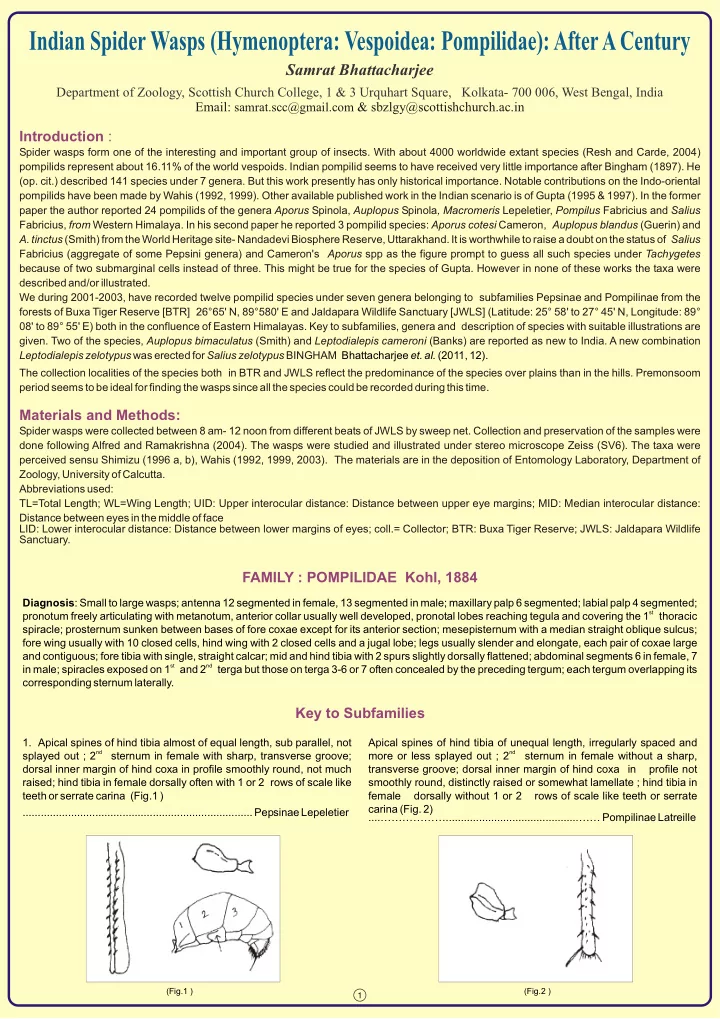

Indian Spider Wasps (Hymenoptera: Vespoidea: Pompilidae): After A Century Samrat Bhattacharjee Department of Zoology, Scottish Church College, 1 & 3 Urquhart Square, Kolkata- 700 006, West Bengal, India Email: samrat.scc@gmail.com & sbzlgy@scottishchurch.ac.in Introduction : Spider wasps form one of the interesting and important group of insects. With about 4000 worldwide extant species (Resh and Carde, 2004) pompilids represent about 16.11% of the world vespoids. Indian pompilid seems to have received very little importance after Bingham (1897). He (op. cit.) described 141 species under 7 genera. But this work presently has only historical importance. Notable contributions on the Indo-oriental pompilids have been made by Wahis (1992, 1999). Other available published work in the Indian scenario is of Gupta (1995 & 1997). In the former paper the author reported 24 pompilids of the genera Aporus Spinola, Auplopus Spinola , Macromeris Lepeletier, Pompilus Fabricius and Salius Fabricius, from Western Himalaya. In his second paper he reported 3 pompilid species: Aporus cotesi Cameron, Auplopus blandus (Guerin) and A. tinctus (Smith) from the World Heritage site- Nandadevi Biosphere Reserve, Uttarakhand. It is worthwhile to raise a doubt on the status of Salius Fabricius (aggregate of some Pepsini genera) and Cameron's Aporus spp as the figure prompt to guess all such species under Tachygetes because of two submarginal cells instead of three. This might be true for the species of Gupta. However in none of these works the taxa were described and/or illustrated. We during 2001-2003, have recorded twelve pompilid species under seven genera belonging to subfamilies Pepsinae and Pompilinae from the forests of Buxa Tiger Reserve [BTR] 26°65' N, 89°580' E and Jaldapara Wildlife Sanctuary [JWLS] (Latitude: 25° 58' to 27° 45' N, Longitude: 89° 08' to 89° 55' E) both in the confluence of Eastern Himalayas. Key to subfamilies, genera and description of species with suitable illustrations are given. Two of the species, Auplopus bimaculatus (Smith) and Leptodialepis cameroni (Banks) are reported as new to India. A new combination Leptodialepis zelotypus was erected for Salius zelotypus BINGHAM Bhattacharjee et. al. (2011, 12). The collection localities of the species both in BTR and JWLS reflect the predominance of the species over plains than in the hills. Premonsoom period seems to be ideal for finding the wasps since all the species could be recorded during this time. Materials and Methods: Spider wasps were collected between 8 am- 12 noon from different beats of JWLS by sweep net. Collection and preservation of the samples were done following Alfred and Ramakrishna (2004). The wasps were studied and illustrated under stereo microscope Zeiss (SV6). The taxa were perceived sensu Shimizu (1996 a, b), Wahis (1992, 1999, 2003). The materials are in the deposition of Entomology Laboratory, Department of Zoology, University of Calcutta. Abbreviations used: TL=Total Length; WL=Wing Length; UID: Upper interocular distance: Distance between upper eye margins; MID: Median interocular distance: Distance between eyes in the middle of face LID: Lower interocular distance: Distance between lower margins of eyes; coll.= Collector; BTR: Buxa Tiger Reserve; JWLS: Jaldapara Wildlife Sanctuary. FAMILY : POMPILIDAE Kohl, 1884 Diagnosis : Small to large wasps; antenna 12 segmented in female, 13 segmented in male; maxillary palp 6 segmented; labial palp 4 segmented; st pronotum freely articulating with metanotum, anterior collar usually well developed, pronotal lobes reaching tegula and covering the 1 thoracic spiracle; prosternum sunken between bases of fore coxae except for its anterior section; mesepisternum with a median straight oblique sulcus; fore wing usually with 10 closed cells, hind wing with 2 closed cells and a jugal lobe; legs usually slender and elongate, each pair of coxae large and contiguous; fore tibia with single, straight calcar; mid and hind tibia with 2 spurs slightly dorsally flattened; abdominal segments 6 in female, 7 st nd in male; spiracles exposed on 1 and 2 terga but those on terga 3-6 or 7 often concealed by the preceding tergum; each tergum overlapping its corresponding sternum laterally. Key to Subfamilies 1. Apical spines of hind tibia almost of equal length, sub parallel, not Apical spines of hind tibia of unequal length, irregularly spaced and nd nd splayed out ; 2 sternum in female with sharp, transverse groove; more or less splayed out ; 2 sternum in female without a sharp, dorsal inner margin of hind coxa in profile smoothly round, not much transverse groove; dorsal inner margin of hind coxa in profile not raised; hind tibia in female dorsally often with 1 or 2 rows of scale like smoothly round, distinctly raised or somewhat lamellate ; hind tibia in teeth or serrate carina (Fig.1 ) female dorsally without 1 or 2 rows of scale like teeth or serrate carina (Fig. 2) ............................................................................ Pepsinae Lepeletier ....………………............................................…… Pompilinae Latreille (Fig.1 ) (Fig.2 ) 1
Recommend
More recommend